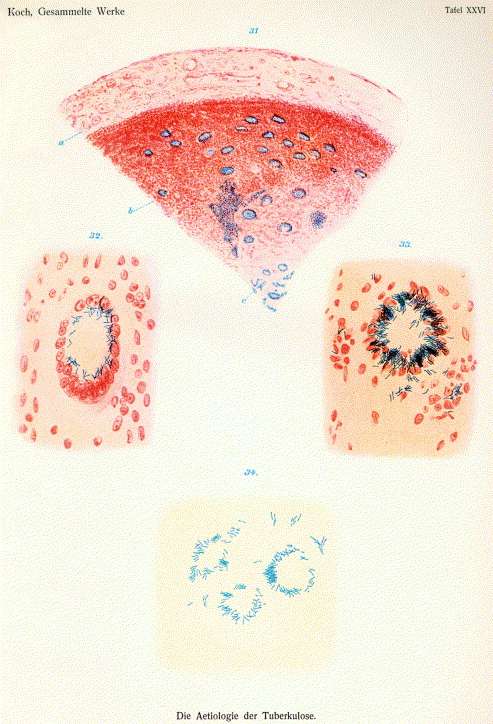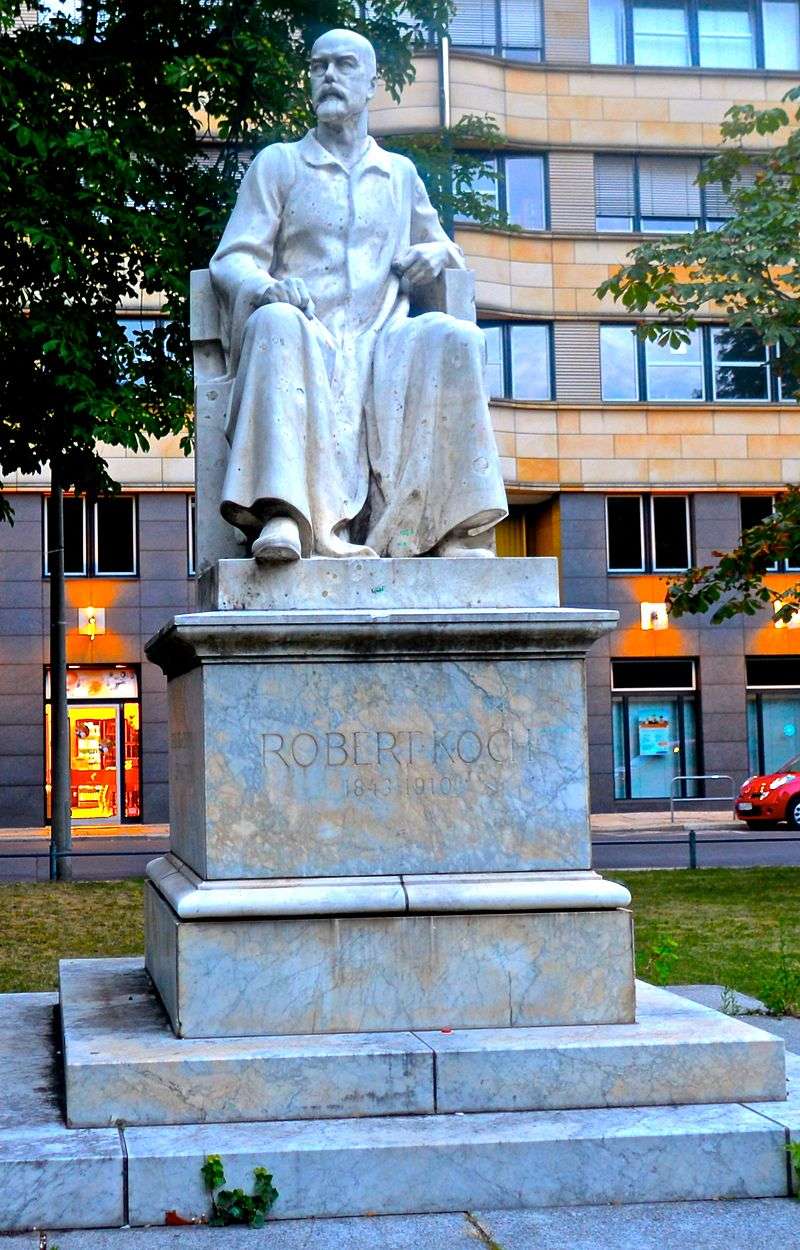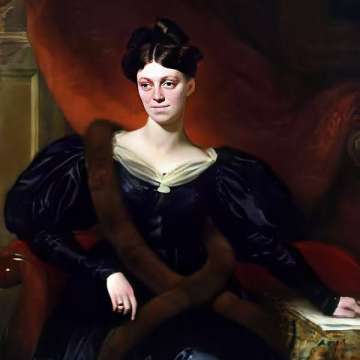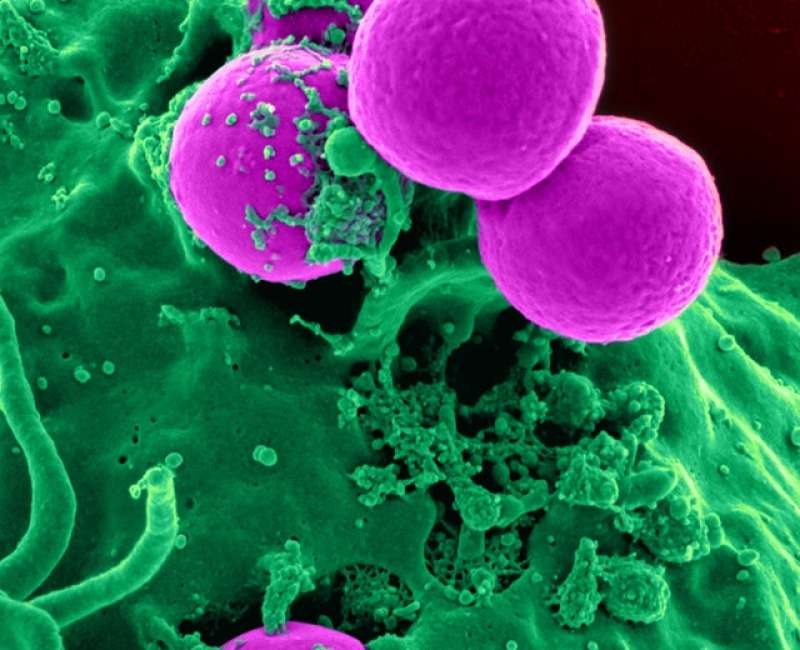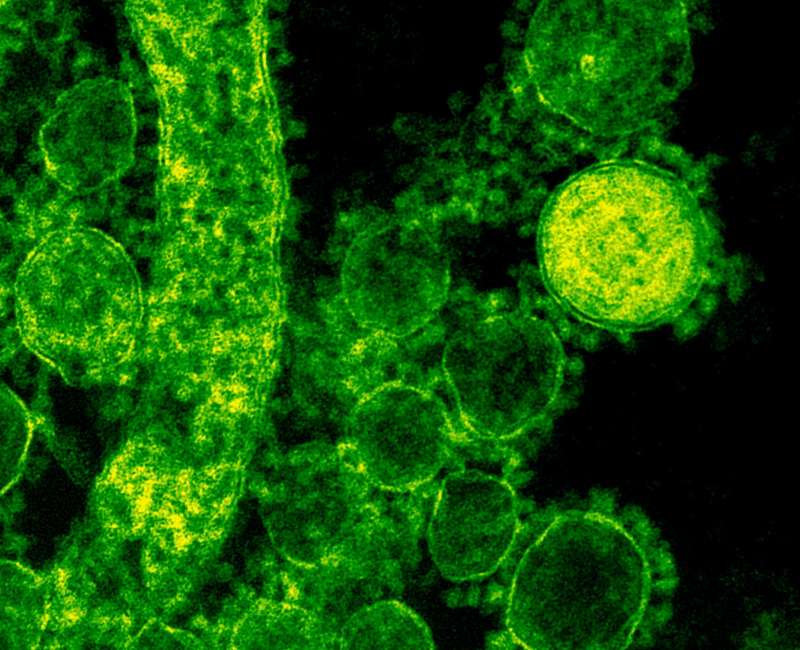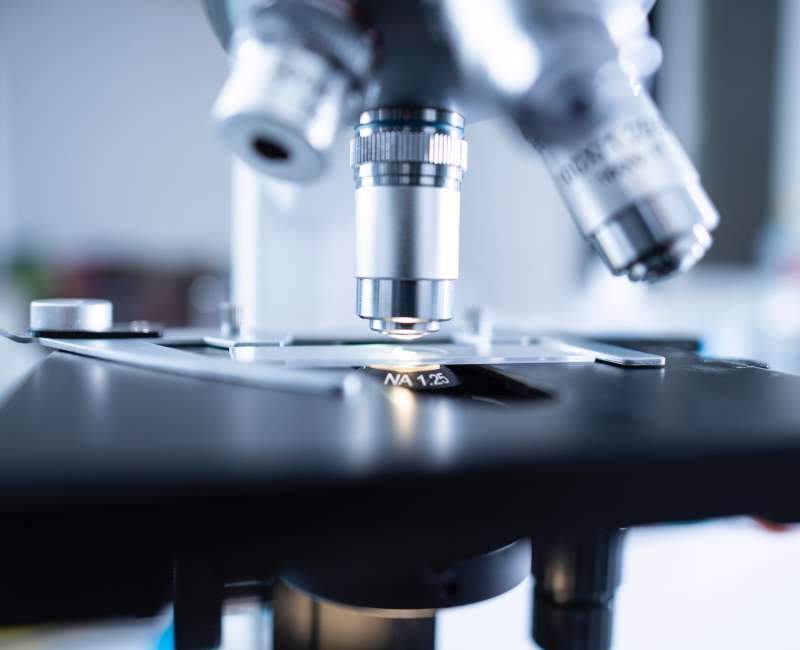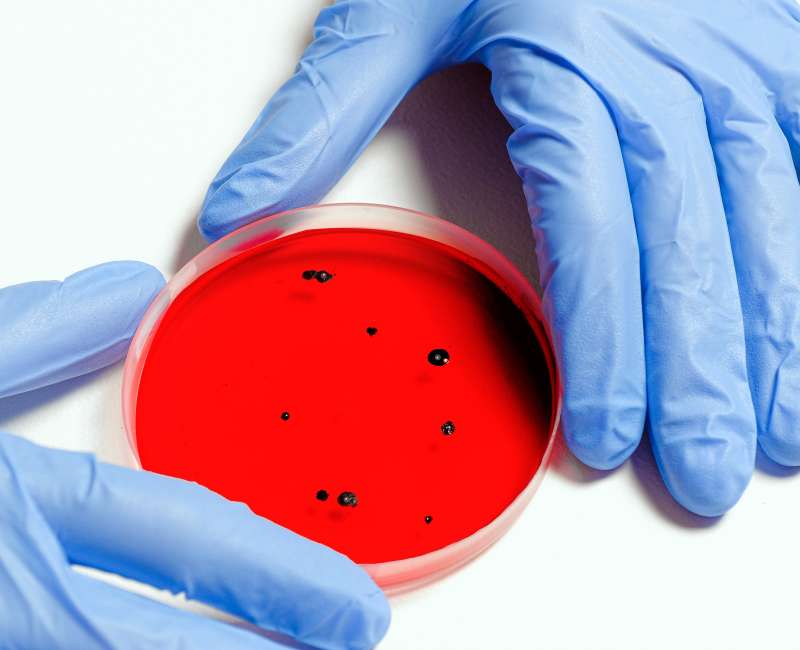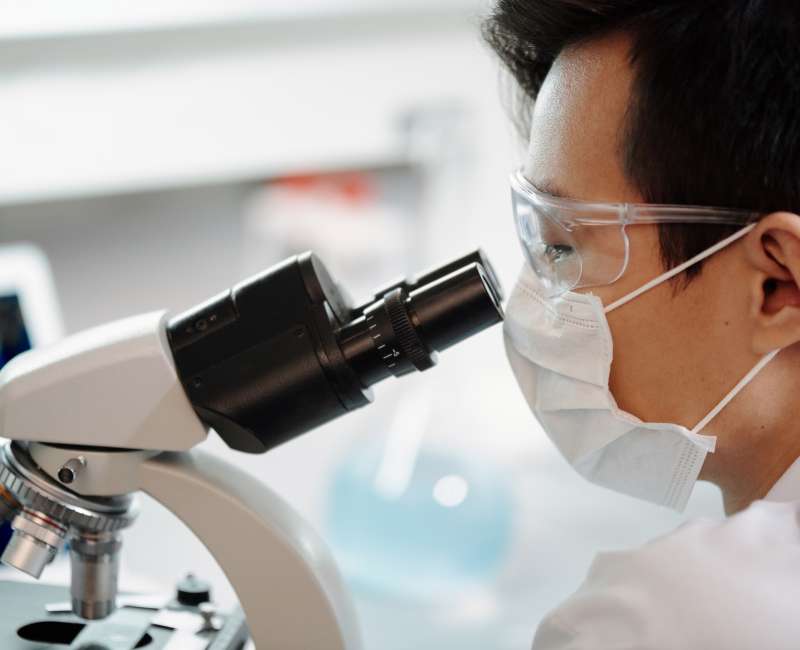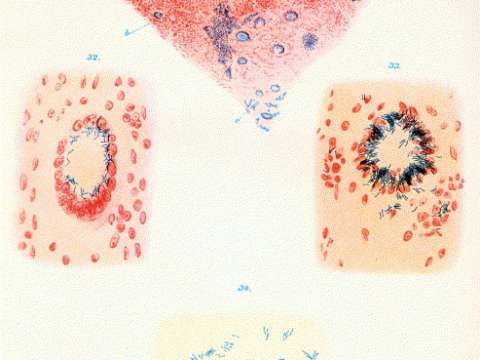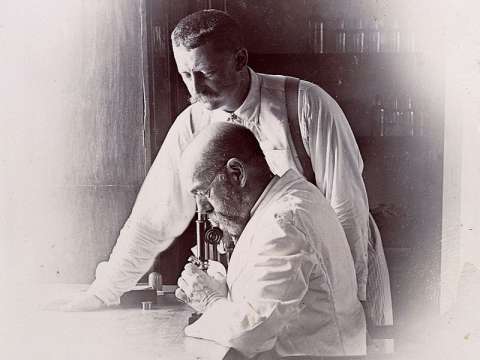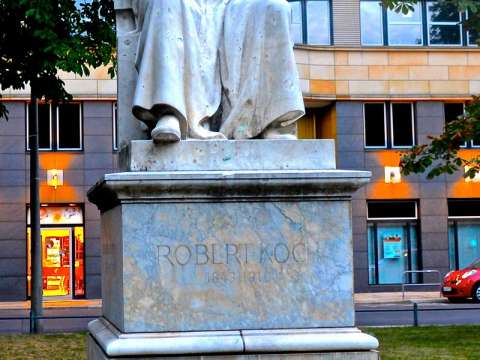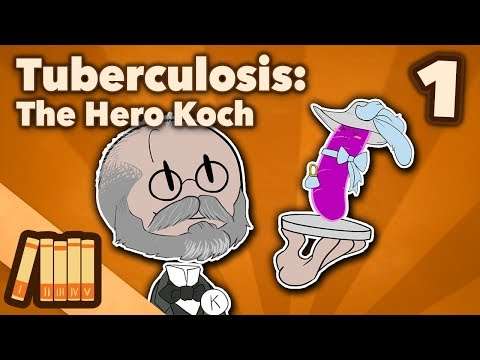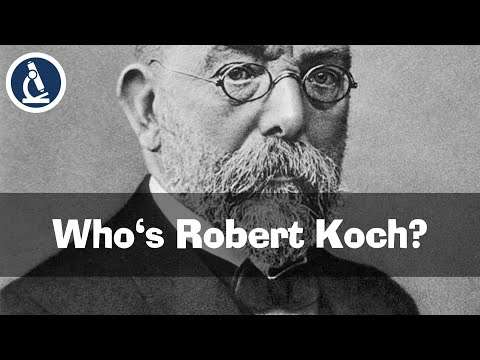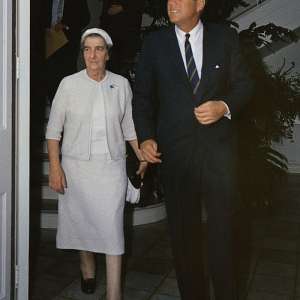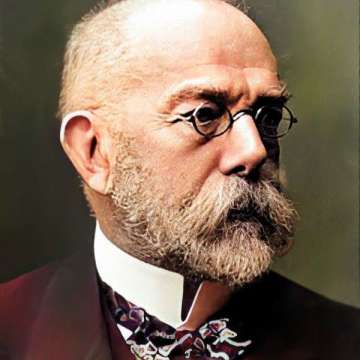

Robert Koch (1843-1910)

If my efforts have led to greater success than usual, this is due, I believe, to the fact that during my wanderings in the field of medicine, I have strayed onto paths where the gold was still lying by the wayside. It takes a little luck to be able to distinguish gold from dross, but that is all.
Heinrich Hermann Robert Koch was a German physician and microbiologist. As one of the main founders of modern bacteriology, he identified the specific causative agents of tuberculosis, cholera, and anthrax and also gave experimental support for the concept of infectious disease, which included experiments on humans and animals. Koch created and improved laboratory technologies and techniques in the field of microbiology, and made key discoveries in public health. His research led to the creation of Koch's postulates, a series of four generalized principles linking specific microorganisms to specific diseases that proved influential on subsequent epidemiological principles such as the Bradford Hill criteria. For his research on tuberculosis, Koch received the Nobel Prize in Physiology or Medicine in 1905. The Robert Koch Institute is named in his honour.
Early life and education
Koch was born in Clausthal, Germany, on 11 December 1843, to Hermann Koch 1814–1877 and Mathilde Julie Henriette née Biewend; 1818–1871. Koch excelled academically from an early age. Before entering school in 1848, he had taught himself how to read and write. He graduated from high school in 1862, having excelled in science and math. At the age of 19, Koch entered the University of Göttingen, studying natural science. However, after three semesters, Koch decided to change his area of study to medicine, as he aspired to be a physician. During his fifth semester of medical school, Jacob Henle, an anatomist who had published a theory of contagion in 1840, asked him to participate in his research project on uterine nerve structure. In his sixth semester, Koch began to research at the Physiological Institute, where he studied the secretion of succinic acid, which is a signaling molecule that is also involved in the metabolism of the mitochondria. This would eventually form the basis of his dissertation. In January 1866, Koch graduated from medical school, earning honors of the highest distinction.
Career
After graduation in 1866, Koch briefly work as an assistant in the General Hospital of Hamburg. In October that year he moved to Idiot's Hospital of Langenhagen, near Hanover, as a general physician. In 1868, he moved to Neimegk and then to Rakwitz in 1869. As the Franco-Prussian War started in 1870, he enlisted in the German army as a volunteer surgeon in 1871 to support the war effort. He was discharged a year later and was appointed as a district physician (Kreisphysikus) in Wollstein in Prussian Posen (now Wolsztyn, Poland). As his family settled there, his wife presented him a microscope as a birthday gift. With the miscroscope, he set up a private laboratory and started his career in microbiology.
Koch began conducting research on microorganisms in a laboratory connected to his patient examination room. His early research in this laboratory yielded one of his major contributions to the field of microbiology, as he developed the technique of growing bacteria. Furthermore, he managed to isolate and grow selected pathogens in pure laboratory culture. His discovery of anthrax bacillus (later named Bacillus anthracis) hugely impressed Ferdinand Julius Cohn, professor at the University of Breslau (now University of Wrocław), who helped him publish the discovery in 1876. Cohn had established the Institute of Plant Physiology and invited Koch to demonstrate his new bacterium there in 1877. Koch was transferred to Breslau as district physician in 1879. A year after, he left for Berlin as he was appointed as government advisor at the Imperial Health Office, where he worked from 1880 to 1885. Following his discovery of tuberculosis bacterium, he was promoted to Geheimer Regierungsrath, a senior executive position in June 1882.
In 1885, Koch received two appointments as an administrator and professor at Berlin University. He became Director of Hygienic Institute and Chair (Professor of hygiene) of the Faculty of Medicine. In 1891, he relinquished his professorship and became a director of the Royal Prussian Institute for Infectious Diseases (now the Robert Koch Institute) which consisted of a clinical division and beds for the division of clinical research. For this he accepted harsh conditions. The Prussian Ministry of Health insisted after the 1890 scandal with tuberculin, which Koch had discovered and intended as a remedy for tuberculosis, that any of Koch's inventions would unconditionally belong to the government and he would not be compensated. Koch lost the right to apply for patent protection. In 1906, he moved to East Africa to research a cure for trypanosomiasis (sleeping sickness). He established the Bugula research camp where up to 1000 people a day were treated with the experimental drug Atoxyl.
Research
Isolating pure bacterial cultures
In an attempt to grow bacteria, Koch began to use solid nutrients such as potato slices. Through these initial experiments, Koch observed individual colonies of identical, pure cells. He found that potato slices were not suitable media for all organisms, and later began to use nutrient solutions with gelatin. However, he soon realized that gelatin, like potato slices, was not the optimal medium for bacterial growth, as it did not remain solid at 37 °C, the ideal temperature for growth of most human pathogens. As suggested to him by Walther and Fanny Hesse, Koch began to utilize agar to grow and isolate pure cultures, because this polysaccharide remains solid at 37 °C, is not degraded by most bacteria, and results in a transparent medium.
Development of Petri dish
Koch's booklet published in 1881 titled "Zur Untersuchung von Pathogenen Organismen" (Methods for the Study of Pathogenic Organisms) has been known as the "Bible of Bacteriology." In it he described a novel method of using glass slide with agar to grow bacteria. The method involved pouring a liquid agar on to the glass slide and then spreading a thin layer of gelatin over. The gelatin made the culture medium solidify by in which bacterial samples could be spread uniformly. The whole bacterial culture was then put in a glass plate together with a small wet paper. Koch named this container as feuchte Kammer (moist chamber). The typical chamber was a circular glass dish 20 cm in diameter and 5 cm in height and had a lid to prevent contamination. The glass plate and the transparent culture media made observation of the bacterial growth easy.

Koch publicly demonstrated his plating method at the Seventh International Medical Congress in London in August 1881. There, Louis Pasteur exclaimed, "C'est un grand progrès, Monsieur!" ("What a great progress, Sir!") It was using Koch's microscopy and agar-plate culture method that his students discovered new bacteria. Friedrich Loeffler discovered the bacteria of glanders (Burkholderia mallei) in 1882 and diphtheria (Corynebacterium diphtheriae) in 1884; and Georg Theodor August Gaffky, the bacterium of typhoid (Salmonella enterica) in 1884. Koch's assistant Julius Richard Petri developed an improved method and published it in 1887 as "Eine kleine Modification des Koch’schen Plattenverfahrens" (A minor modification of the plating technique of Koch).The culture plate was given an eponymous name Petri dish. It is often asserted that Petri developed a new culture plate, but is was not so. He simply discarded the use of glass plate and instead used the circular glass dish directly, not just as moist chamber, but as the main culture container. This further reduced chances of contaminations. It would also have been appropriate if the name "Koch dish" had been given.
Anthrax
Robert Koch is widely known for his work with anthrax, discovering the causative agent of the fatal disease to be Bacillus anthracis. He discovered the formation of spores in anthrax bacteria, which could remain dormant under specific conditions. However, under optimal conditions, the spores were activated and caused disease. To determine this causative agent, he dry-fixed bacterial cultures onto glass slides, used dyes to stain the cultures, and observed them through a microscope. His work with anthrax is notable in that he was the first to link a specific microorganism with a specific disease, rejecting the idea of spontaneous generation and supporting the germ theory of disease.
Cholera
In August 1883, the German government sent a medical team led by Koch to Alexandria, Egypt, to investigate cholera epidemic there. Koch soon found that the intestinal mucosa of people who died of cholera always had bacterial infection, yet could not confirm whether the bacteria were the causative pathogens. As the outbreak in Egypt declined, he was transferred to Calcutta (now Kolkata) India, where there was a more severe outbreak. He soon found that the river Ganges was the source of cholera. He performed autopsies of almost 100 bodies, and found in each bacterial infection. He identified the same bacteria from water tanks, linking the source of the infection. He isolated the bacterium in pure culture on 7 January 1884. He subsequently confirmed that the bacterium was a new species, and described as "a little bent, like a comma." His experiment using fresh blood samples indicated that the bacterium could kill red blood cells, and he hypothesized that some sort of poison was used by the bacterium to cause the disease. The poison was discovered by an Indian scientist Sambhu Nath De in 1959 and is known as cholera toxin. Koch reported his discovery to the German Secretary of State for the Interior on 2 February, and published it in the Deutsche Medizinische Wochenschrift (German Medical Weekly) the following month.

Although Koch was convinced that the bacterium was the cholera pathogen, he could not entirely establish a critical evidence the bacterium produced the symptoms in healthy subjects (following Koch's postulates). His experiment on animals using his pure bacteria culture did not cause the disease, and correctly explained that animals are immune to human pathogen. The bacterium was then known as "the comma bacillus", and scientifically as Bacillus comma. It was later realised that the bacterium was already described by an Italian physician Filippo Pacini in 1854, and was also observed by the Catalan physician Joaquim Balcells i Pascual around the same time. But they failed to identify the bacterium as the causative agent of cholera. Koch's colleague Richard Friedrich Johannes Pfeiffer correctly identified the comma bacillus as Pacini's vibrioni and renamed it as Vibrio cholera in 1896.
Tuberculosis
During his time as the government advisor with the Imperial Health Agency in Berlin in the 1880s, Robert Koch became interested in tuberculosis research. At the time, it was widely believed that tuberculosis was an inherited disease. However, Koch was convinced that the disease was caused by a bacterium and was infectious. In 1882, he published his findings on tuberculosis, in which he reported the causative agent of the disease to be the slow-growing Mycobacterium tuberculosis. He published the discovery as "Die Ätiologie der Tuberkulose" (The Etiology of Tuberculosis), and presented before the German Physiological Society at Berlin on 24 March 1882. Koch announced, saying,
When the cover-glasses were exposed to this staining fluid [methylene blue mixed with potassium hydroxide] for 24 hours, very fine rod-like forms became apparent in the tubercular mass for the first time, having, as further observations showed, the power of multiplication and of spore formation and hence belonging to the same group of organisms as the anthrax bacillus... Microscopic examination then showed that only the previously blue-stained cell nuclei and detritus became brown, while the tubercle bacilli remained a beautiful blue.
There was no particular reaction to this announcement. Eminent scientist such as Rudolf Virchow remained skeptical. Virchow clung to his theory that all diseases are due to faulty cellular activities, On the other hand, Paul Ehrlich later recollected that this moment was his "single greatest scientific experience." Koch expanded the report and published under the same title as a booklet in 1884, in which he concluded that the discovery of tuberculosis bacterium fulfilled the three principles, eventually known as Koch's postulates, which were formulated by his assistant Friedrich Loeffler in1883, saying:
All these factors together allow me to conclude that the bacilli present in the tuberculous lesions do not only accompany tuberculosis, but rather cause it. These bacilli are the true agents of tuberculosis.
Acquired immunity
Koch observed the phenomenon of acquired immunity. On 26 December 1900, he arrived as part of an expedition to German New Guinea, which was then a protectorate of the German Reich. Koch serially examined the Papuan people, the indigenous inhabitants, and their blood samples and noticed they contained Plasmodium parasites, the cause of malaria, but their bouts of malaria were mild or could not even be noticed, i.e. were subclinical. On the contrary, German settlers and Chinese workers, who had been brought to New Guinea, fell sick immediately. The longer they had stayed in the country, however, the more they too seemed to develop a resistance against it.
Koch's four postulates
During his time as government advisor, Koch published a report, in which he stated the importance of pure cultures in isolating disease-causing organisms and explained the necessary steps to obtain these cultures, methods which are summarized in Koch's four postulates. Koch's discovery of the causative agent of anthrax led to the formation of a generic set of postulates which can be used in the determination of the cause of most infectious diseases. These postulates, which not only outlined a method for linking cause and effect of an infectious disease but also established the significance of laboratory culture of infectious agents, are listed here:
- The organism must always be present, in every case of the disease.
- The organism must be isolated from a host containing the disease and grown in pure culture.
- Samples of the organism taken from pure culture must cause the same disease when inoculated into a healthy, susceptible animal in the laboratory.
- The organism must be isolated from the inoculated animal and must be identified as the same original organism first isolated from the originally diseased host.
Personal life
In July 1867, Koch married Emma Emmy Adolfine Josephine Fraatz, and the two had a daughter, Gertrude, in 1868. Their marriage ended after 26 years in 1893, and later that same year, he married actress Hedwig Freiberg 1872–1945.

On 9 April 1910, Koch suffered a heart attack and never made a complete recovery. On 27 May, three days after giving a lecture on his tuberculosis research at the Prussian Academy of Sciences, Koch died in Baden-Baden at the age of 66. Following his death, the Institute named its establishment after him in his honour. He was irreligious.
Awards and honors
In 1897, Koch was elected a Foreign Member of the Royal Society (ForMemRS). In 1905, he was awarded the Nobel Prize in Physiology and Medicine "for his investigations and discoveries in relation to tuberculosis." In 1906, research on tuberculosis and tropical diseases won him the Prussian Order Pour le Merite and in 1908, the Robert Koch Medal, established to honour the greatest living physicians. Emperor Wilhelm I awarded him the Order of the Crown, 100,000 marks and appointment as Privy Imperial Councillor, Surgeon-General of Health Service, and Fellow of the Science Senate of Kaiser Wilhelm Society.
Koch established the Royal Prussian Institute for Infectious Diseases in Berlin 1891. After his death it was renamed Robert Koch Institute in his honour.
The World Health Organization observes "World Tuberculosis Day" every 24 March since 1982 to commemorate the day Koch discovered tuberculosis bacterium.

Koch's name is one of 23 from the fields of hygiene and tropical medicine featured on the frieze of the London School of Hygiene & Tropical Medicine building in Keppel Street, Bloomsbury.
A large marble statue of Koch stands in a small park known as Robert Koch Platz, just north of the Charity Hospital, in the Mitte section of Berlin. His life was the subject of a 1939 German produced motion picture that featured Oscar winning actor Emil Jannings in the title role. On 10 December 2017, Google showed a Doodle in celebration of Koch's birthday.
Koch and his relationship to Paul Ehrlich, who developed a mechanism to diagnose TB, were portrayed in the 1940 movie Dr. Ehrlich's Magic Bullet.
Controversies
Louis Pasteur
At their first meeting at the Seventh International Medical Congress in London in August 1881, Koch and Pasteur were friendly towards each other. But the rest of their careers followed with scientific disputes. The conflict started when Koch interpreted his discovery of anthrax bacillus in 1876 as causality, that is, the germ caused the anthrax infections. Although his postulates were not yet formulated, he did not establish the bacterium as the cause of the disease: it was an inference. Pasteur therefore argued that Koch's discovery was not the full proof of causality, but Pasteur's anthrax vaccine developed in 1881 was. Koch published his conclusion in 1881 with a statement: "anthrax never occurs without viable anthrax bacilli or spores. In my opinion no more conclusive proof can be given that anthrax bacilli are the true and only cause of anthrax," and that vaccination such as claimed by Pasteur would be impossible. To prove his vaccine, Pasteur sent his assistant Louis Thuillier to Germany for demonstration and disproved Koch's idea. They had a heated public debate at the International Congress for Hygiene in Geneva in 1882, where Koch criticised Pasteur's methods as "unreliable," and claimed they "are false and [as such ] they inevitably lead to false conclusions." Koch later continued to attack Pasteur, saying, "Pasteur is not a physician, and one cannot expect him to make sound judgments about pathological processes and the symptoms of disease."
Tuberculin
When Koch discovered tuberculin in 1890 as a medication for tuberculosis, he kept the experiment secret and avoided disclosing the source. It was only after a year under public pressure that he publicly announced the experiment and the source. Clinical trials with tuberculin were disastrous and complete failures. Rudolf Virchow's autopsy report of 21 subjects treated with tuberculin to the Berlin Medical Society on 7 January 1891 revealed that instead of healing tuberculosis, the subjects died because of the treatment. One week later, Koch publicised that the drug was a glycerine extract of a pure cultivation of the tuberculosis bacilli. The German official report in the late 1891 declared that tuberculosis was not cured with tuberculin. From this moment onwards, Koch's prestige fell apart. The reason for his initial secrecy was due to an ambition for monetary benefits for the new drug, and with that establishment of his own research institute. Since 1885, he had tried to leave government service and create an independent state-run institute of his own. Following the disappointment, he was released from the University of Berlin and forced to work as Director of the Royal Prussian Institute for Infectious Diseases, a newly established institute, in 1891. He was prohibited from working on tuberculin and from claim for patent rights in any of his subsequent works.
Human and cattle tuberculosis
Koch initially believed that human (Mycobacterium tuberculosis) and cattle tuberculosis bacilli (now called Mycobacterium bovis) were different pathogens when he made the discovery in 1882. Two years later, he revoked that position and asserted that the two bacilli were the same type. This later assumption was taken as a fact in veterinary practice. Based on it, legislations were made in US for inspection of meat and milk. In 1898, an American veterinarian Theobald Smith published a detailed comparative study and found that the tuberculosis bacteria are different based on their structure, growth patterns, and pathogenicity. In addition he also discovered that there were variations in each type. In his conclusion, he made two important points:
- Human tuberculosis bacillus cannot infect cattle.
- But cattle bacillus may infect humans since it is very pathogenic.
By that time, there was evidence that cattle tuberculosis was transmitted to humans through meat and milk. Upon these reports, Koch conceded that the two bacilli were different but still advocated that cattle tuberculosis was of no health concern. Speaking at the Third International Congress on Tuberculosis, held in London in July 1901, he said that cattle tuberculosis is not dangerous to humans and there is no need for medical attention. He said, "I therefore consider it unnecessary to take any measures against this form of TB. The fight against TB clearly has to concentrate on the human bacillus." Chair of the congress, Joseph Lister reprimanded Koch and explained the medical evidences of cattle tuberculosis in humans.
The 1902 Nobel Prize in Physiology or Medicine
The Nobel Committee selected the 1902 Nobel Prize in Physiology or Medicine for the discovery of transmission of malaria. But it could not make final decision on who to give, a British surgeon Ronald Ross or an Italian biologist Giovanni Battista Grassi. Ross had discovered that human malarial parasite was carried by certain mosquito in 1897, and the next year that bird malaria could be transmitted by infected to healthy birds by the bite of mosquito. Grassi had discovered Plasmodium vivax and bird malaria parsite, and towards the end of 1898, the transmission of Plasmodium falciparum between humans by the mosquito Anopheles claviger. To the surprise of the Nobel Committee, the two nominees exchanged polemic arguments against each other publicly justifying the importance of their works. Robert Koch was then appointed as a "neutral arbitrator" to make the final decision. To his disadvantage, Grassi had criticised Koch on malaria research 1898 during an investigation of the epidemic, and Ross had established cordial relationship with Koch. Ross was selected for the award, as Koch "threw the full weight of his considerable authority in insisting that Grassi did not deserve the honor."
More facts
Koch's postulates
Germ theory
Discovery of anthrax bacillus
Discovery of tuberculosis bacillus
Discovery of cholera bacillus

